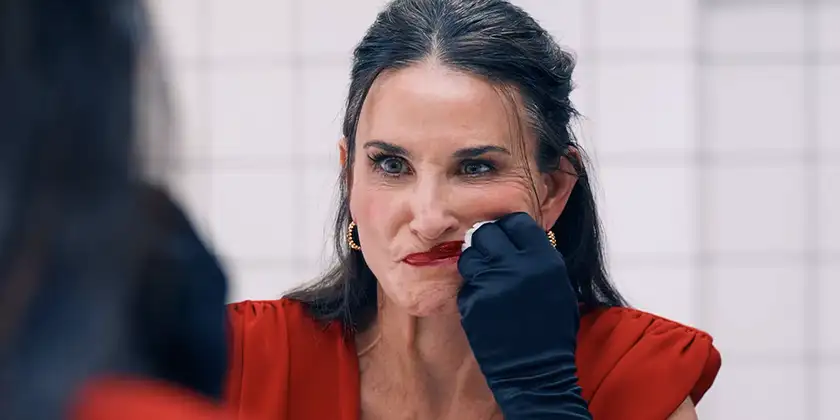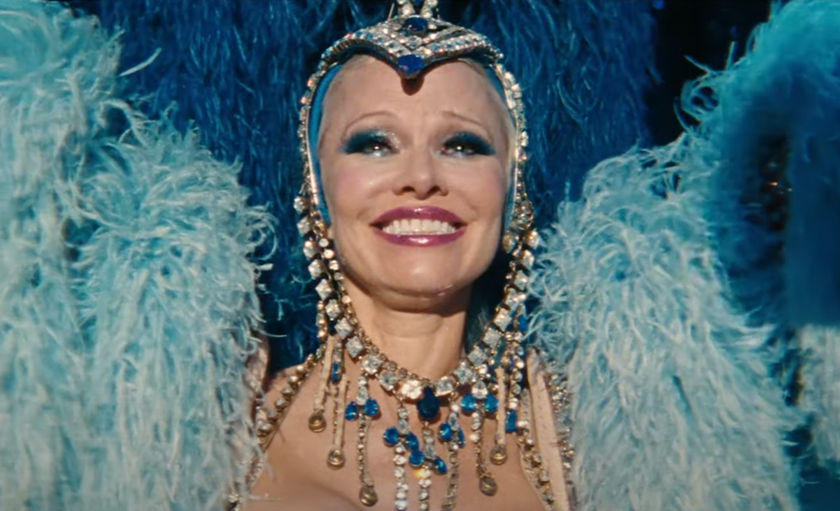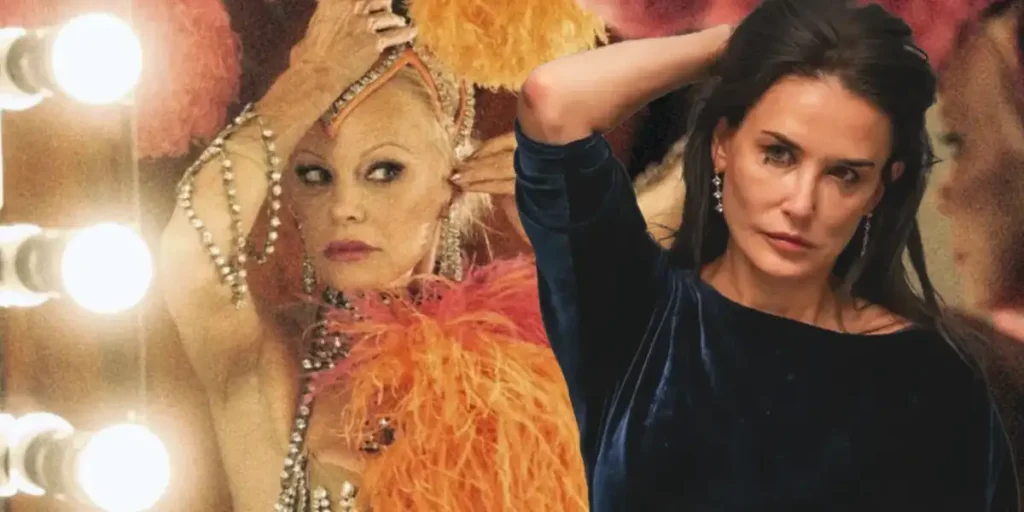The Substance and The Last Showgirl are drastically different in approach, but create nuanced conversation about women aging in Hollywood and modern beauty standards.
In 2024, we were lucky enough to have two dramatically different films that tackled aging in Hollywood through the female lens. The Substance, written and directed by Coralie Fargeat, shows the tortuous lengths to which women in the public eye have to go to stay relevant. The Last Showgirl, directed by Gia Coppola, depicts the pain of aging out of show business after you have sacrificed everything to be a part of it.
Stylistically, The Substance and The Last Showgirl could not be any further from one another. Fargeat implements the use of intensive primary colors, extreme close-ups and a pulsating score to build the world of The Substance. In contrast, Coppola utilizes a faded pastel color scheme, organic lighting and extravagant costuming to bring us into The Last Showgirl.
Additionally, the tones of these films are polar opposites. The Substance is a satirical dark comedy that reinvents the concept of body horror whereas The Last Showgirl is a dreamlike, understated drama. However, the underlying message of these two films creates an extremely nuanced conversation about women aging in Hollywood, the ludicracy of modern beauty standards and societal expectations placed on women.
How The Substance Address Women Aging in Hollywood
Coralie Fargeat’s The Substance follows Elisabeth Sparkle (Demi Moore), a once-prolific Hollywood starlet. Elisabeth has fallen out of the public spotlight as she has aged, condemned now to leading a daytime aerobics program. On her 50th birthday, the studio executives push her out and she is forced to grieve what was seemingly left of her career. After receiving a mysterious note and flash drive, Elisabeth is introduced to The Substance. The Substance is an experience that promises to give you a younger, more beautiful, more perfect version of yourself.
Seeing no hope for her future and in the depths of her own self-hatred, Elisabeth takes The Substance and immediately, a star is born. Elisabeth spawns an entirely new body called Sue (Margaret Qualley, of Kinds of Kindness). Sue is half of Elisabeth’s age with no flaws and breathtaking beauty. The rules of The Substance are that both Sue and Elisabeth have to take turns with one another, each body getting seven days of being active (while the other lies comatose) before needing to switch with the other. This seven-day balance must be respected.
When Sue emerges into the work, she immediately replaces Elisabeth on her day-time aerobics program which snowballs into a windfall of opportunities for Sue to be on the big screen. The world falls in love with the effortlessly beautiful and impossibly youthful Sue while forgetting entirely about Elisabeth Sparkle.
Fargeat has created a work of art that dares its audience to not look away at the horrors they have unknowingly helped create. The film is an exposition of the lengths women will go to in order to stay young and relevant and the pain that comes from constantly trying to uphold beauty standards when the standard of beauty is constantly changing.
The Substance tackles the concept of women aging in Hollywood with unbridled rage, blatant gore and grotesque imagery. It actualizes the ludicrous expectations society has for women and commentates on the controversy about plastic surgery by putting its main character through the most extreme form of body modification that’s ever been shown on screen. The film effortlessly encapsulates, and furthermore accentuates, the feeling of outrage and helplessness we feel when trying to live up to impossible standards.
By the end of the film, both Elisabeth and Sue transform into literal monsters, which shows even though Sue was supposed to be a perfect version of Elisabeth, perfection isn’t even enough. Age gets to all of us, and no matter how hard we try, the relentless pursuit of beauty will always leave us lost in a sea of self-doubt and, at its most extreme, self-hatred.
The Last Showgirl’s Approach to Women Aging in Show Business
Gia Coppola’s latest feature The Last Showgirl is a tragic tale about what is sacrificed in the pursuit of fame. The film follows Shelly (Pamela Anderson, of Pamela: A Love Story), a Las Vegas showgirl struggling to come to terms with her show coming to a close. Shelly was a part of The Razzle Dazzle, Vegas’ last true showgirl performance, which ran for 30 years.
While other acts have closed, Shelly believed this show would live on as she saw it as not only a piece of Las Vegas history but American history. This show sent her around the world; it made her a star and, in all actuality, it gave her a purpose. When news breaks the show will be giving its final performance in a few weeks time, Shelly panics trying to figure out what’s next for her.
Even though Shelly tries to audition for new shows, it’s a young woman’s game. The dances talent scouts want to see are too overtly sexual for Shelly and she believes the new shows on the Vegas strip are completely tasteless. While the younger dancers at The Razzle Dazzle see their show as a dinosaur on the strip, Shelly believes its history separates it from the exploitative and explicit shows that have been threatening this art form she has been a part of building.
Shelly has given up a marriage and a relationship with her daughter to be a part of this show. There is nothing she refused to sacrifice in order to be a showgirl. But the same attributes that lead to her success at The Razzle Dazzle no longer hold up in the modern world. She was picked to be in the show all those years ago for her beauty and youth, not any real talent, and she cannot come to terms with this in the present day. She lives and obsesses over a time that the modern world has forgotten.
Coppola masterfully shows the reality of show business while encapsulating the whimsey that surrounds it. Shelly still looks at the world of show business through an almost child-like lens because it has always been kind to her. She was willing to do anything to be a part of it, give up anything to make room for it. She often visits the casinos and theaters to just stand in the light, trying to almost recreate what it was like to be seen as a star. Coppola cuts these shots with ones of her reality to show audiences how brutal and unsettling it feels when you are forced out of the spotlight.
The Pain of Comparison in The Substance and The Last Showgirl

The Substance and The Last Showgirl serve as a beautiful analysis of the lifespan of a star. Elisabeth is an Oscar winner with a star on the Hollywood Walk of Fame and yet knows her career is done the minute she is let go of network TV. Shelly was one of the ambassadors for one of the most famous shows on the Las Vegas Strip. She was the lead of the show for 12 years and flown to the Great Wall of China for advertisement spots in her heyday yet has to lie about her age at auditions now to even be looked at.
These women have felt the sun shine on them in ways most people only ever dream of and now have been forever relegated to darkness. They’ve been discarded by show business. Their looks no longer fall in line with the modern beauty standard, even though they helped build the foundation of it.
In one of the most potent scenes in The Subtance, Elisabeth tries to go out into the world on her own after having understood what life is like as Sue. She gets ready for a date with a man she knew back in middle school before she became the Elisabeth Sparkle; he still sees her as the most beautiful girl in the world. She gets ready, feeling confident and excited to re-enter the world as Elisabeth and not Sue; it’s the first time she has done so since taking The Substance. However, when she is about to leave, she sees Sue’s perfect, young body and the confidence visibly drains from her.
Elisabeth decides to add some more makeup and cover her cleavage, now embarrassed of the way she looks compared to someone as young and beautiful as Sue. However, no change she makes to her appearance can mend what has just snapped inside of her. Instead, in a fit of pure self-disgust, Elisabeth violently rubs all the makeup off her face.
She looks so enraged it seems like she’s almost trying to somehow rip the makeup off herself. It encapsulates the isolating feeling of trying your hardest to look beautiful just to come to the realization it will never be enough. No amount of makeup and no “perfect” dress will transform you into the most idealized version of yourself. As Elisabeth breaks down, she realizes she never truly wants to be herself again. Not when being Sue is an option.
Elisabeth cannot help but compare herself to Sue. In truth, before Sue came into the picture, Elisabeth was already being held to impossible standards of what she should look like. Her aerobics filming studio lined the walls with posters of her from back when the show started, when she was at her “peak” and still profitable to the network. All recent photos of her, including the one that is the centerpiece in her apartment, have copious and noticeable amounts of photo retouching to make her appear younger and virtually perfect.
Taking The Substance actualized the fear that Elisabeth has always secretly had: she is not and has never been enough. Her time in Hollywood has morphed her into a version of herself that never existed. Her image is shrouded by pictures of her at her peak, nostalgia for a time when she was feverishly sought after, but even back then was she ever really enough? Was she always chasing a form of perfection she’d never be able to reach?
In The Last Showgirl, Shelly has been at The Razzle Dazzle for the past 30 years, she has had to witness the arrival and departure of hundreds of younger, more beautiful versions of herself. While they all respect her as the blueprint for what a Vegas showgirl should look like, these young girls are modified, more beautiful versions of her. Their youth provides them with options of shows to go to once The Razzle Dazzle closes that Shelly truly has no access to due to her age.
While the young women at The Razzle Dazzle look up to Shelly, they also cast her as a matriarchal figure, which she unwillingly goes along with. The young, beautiful and troubled dancer Jodie (Kiernan Shipka of Sweethearts) takes up a strong kinship with Shelly and constantly turns to her for warmth and comfort. Even though Jodie does this out of a place of innocence, Shelly does not want to be cast in this role. She feels it takes away from her true intent at The Razzle Dazzle, to be an artist.
Shelly doesn’t understand why the way people see her has changed so drastically due to her age. She doesn’t want to be seen as the mother or the caretaker of these young girls. She wants to be appreciated as an artist, it’s all she has wanted her entire life. She longs to be back at the center of the stage and not condemned to the back row to make room for those seen as more youthful and more beautiful than her. She holds no ill will towards Jodie and the younger girls, but towards a system that has given her an expiration date and no backup plan.
The Prison of Fame in The Substance and The Last Showgirl

Elisabeth and Shelly have helped build a system that, with time, has forgotten them, or even worse yet, pushed them out. The two characters have been taught that, in show business, youth and beauty are your only real currency, and if you have enough of it, you will be truly loved. They have both known the best and worst this can do to you. While fame has been the vehicle driving their lives forward, they have truly become prisoners of it.
Throughout The Substance, Sue becomes increasingly disrespectful of the balance, stealing days away from Elisabeth. This leads to severe consequences for Elisabeth and she contemplates the possibility of ending this experience. While Elisabeth is seething with hatred towards Sue and all she has stolen from her, she comes to a realization: even though Sue ruining her life, she cannot live without her. She admits Sue is the only loveable part of herself, the only part of herself other people care about considering how quick the world was to forget about the life and career of Elisabeth Sparkle.
In The Last Showgirl, while Shelly is at a dinner with The Razzle Dazzle’s stage manager Edie (Dave Bautista) he asks her if she needed to choose being in this show over her raising her daughter. In this moment Shelly finally explodes with frustration. No one understands what this show and being a part of it gives her. She confesses that, when she is onstage, she feels good about herself: she feels seen and important, and she cannot imagine her life without that. We witness Shelly’s life outside the show and there she is just like everyone else. Unlucky in love, living a very normal life. Being a showgirl is what makes her feel special, what makes her feel important and it is something she wants to hold tight to.
Elisabeth and Shelly have been trained, as many women have been, that their self-worth comes from outward validation. When the fame and shows that have provided them with endless outside approval leave them behind, they are left with nothing to help them rebuild their relationship with their self-worth.
The Conversation About Women Aging In Hollywood that Exists Between The Substance and The Last Showgirl

For Elisabeth and Shelly, their beauty and youth gave them a purpose. People in show business told them to lean into it and build their lives around it. Attention became the only currency that mattered; they felt valued when they were admired as we all do. However, once they dared to age, they were being admired less and less. People became critical of the way they aged and, even worse, vocal about it. Being in the public eye creates a weird dissonance between people. There’s a freedom people feel to discuss people’s looks and bodies as if there is not another human being on the other side of their analysis but an unfeeling product.
We criticize people for going to extreme lengths to look younger or more beautiful, but we don’t recognize it’s because we, as a society, refuse to acknowledge the beauty that comes from aging. We refuse to be more inclusive in these conversations, which makes women feel a deep-seated need to stay as young and as beautiful as they can. This is especially true for those in the public eye, whose looks and bodies have become par for the course topics of casual conversation.
The Substance and The Last Showgirl take very different approaches to discussing beauty standards and aging in Hollywood; however, their messages are intrinsically linked. They want audiences to look at what it feels like to be discarded when you mature out of the age range that society deems worthy of admiration and attention. They want you to understand the lengths to which women go to be deemed relevant and how, oftentimes, they are ridiculed for doing so. They want you to stop judging women trying to adhere to societal expectations they cannot escape. But above all else, they want you to give grace to women of all ages and stop, for the love of God, stripping away their worth because of how many laps they have done around the sun.

